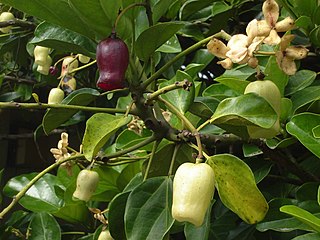
Alangium is a small genus of flowering plants. The genus is included either in a broad view of the dogwood family Cornaceae, or as the sole member of its own family Alangiaceae. Alangium has about 40 species, but some of the species boundaries are not entirely clear. The type species for Alangium is Alangium decapetalum, which is now treated as a subspecies of Alangium salviifolium. All of the species are shrubs or small trees, except the liana Alangium kwangsiense. A. chinense, A. platanifolium, and A. salviifolium are known in cultivation.
Alangium circulare is a tree in the dogwood family Cornaceae. The specific epithet circulare is from the Latin meaning "circular", referring to shape of the leaves.
Alangium havilandii is a tree in the dogwood family Cornaceae. It is named for the British surgeon and naturalist George Darby Haviland.
Alangium longiflorum is a tree in the dogwood family Cornaceae. The specific epithet longiflorum is from the Latin meaning "long flowers".
Alangium nobile is a tree in the dogwood family Cornaceae. The specific epithet nobile is from the Latin meaning "noble" or "distinguished", likely referring to the growth habit.
Maranthes corymbosa is a tree in the family Chrysobalanaceae. The specific epithet corymbosa is from the Greek meaning "cluster", referring to the clustered inflorescences.
Parinari argenteo-sericea is a tree of Borneo in the family Chrysobalanaceae. The specific epithet argenteo-sericea is from the Latin meaning "silvery silky", referring to the pubescence of the inflorescence and flowers.
Barringtonia macrocarpa grows as a shrub or tree up to 30 metres (100 ft) tall, with a trunk diameter of up to 24 centimetres (9 in). The fruits are winged, up to 12.5 cm (5 in) long. Habitat is lowland riverine and swamp forest. B. macrocarpa is found in Burma, Thailand, Vietnam, Malaysia and Indonesia.
Helicia excelsa is a plant in the family Proteaceae. It grows as a tree up to 20 metres (70 ft) tall, with a trunk diameter of up to 25 centimetres (10 in). The bark is dark grey to blackish. Inflorescences bear up to three reddish brown flowers. Fruit is black, ellipsoid, up to 3 centimetres (1 in) long. The specific epithet excelsa is from the Latin meaning "lofty", referring to the tree's growth. Habitat is forests from sea level to 1,700 metres (5,600 ft) altitude. H. excelsa is found in Bangladesh, Burma, Thailand, Malaysia and Indonesia.
Helicia maxwelliana is a plant in the family Proteaceae. It grows as a treelet up to 3 metres (10 ft) tall. The twigs are dark brown. The flowers are reddish brown. The fruit is black, round, up to 2.5 centimetres (1 in) in diameter. Its habitat is montane forest at 1,600 metres (5,200 ft) to 1,700 metres (5,600 ft) altitude. H. maxwelliana is endemic to Borneo.
Helicia pterygota is a plant in the family Proteaceae. It grows as a shrub or small tree up to 7 metres (20 ft) tall, with a stem diameter of up to 6 centimetres (2 in). The bark is brownish. The specific epithet pterygota is from the Greek meaning "winged", referring to the pedicel. Habitat is forests from 1,000 metres (3,300 ft) to 1,800 metres (6,000 ft) altitude. H. pterygota is endemic to Borneo where it is confined to Mount Kinabalu in Sabah.
Diospyros pendula is a tree in the family Ebenaceae. It grows up to 20 metres (70 ft) tall. The fruits are round to ovoid, up to 3.5 cm (1 in) in diameter. The specific epithet pendula is from the Latin meaning "hanging down", referring to the inflorescence. Habitat is lowland mixed dipterocarp forests. D. pendula is found from Indochina to west Malesia.
Dysoxylum alliaceum is a tree in the family Meliaceae. The specific epithet alliaceum is from the Latin meaning "onion-like", referring to the smell of the inner bark.
Dysoxylum arborescens is a tree in the family Meliaceae. The specific epithet arborescens is from the Latin meaning "tree-like".
Walsura pinnata is a tree in the family Meliaceae. The specific epithet pinnata is from the Latin meaning "feather-like", referring to the leaves.
Alangium kurzii is a tree in the family Cornaceae. It is named for the German naturalist Wilhelm Sulpiz Kurz.
Deplanchea bancana is a tree in the family Bignoniaceae. It is named for Sumatra's Bangka Island.
Kostermanthus heteropetalus is a tree in the family Chrysobalanaceae. The specific epithet heteropetalus is from the Greek meaning "uneven or unequal petals".

Atuna racemosa is a tree in the family Chrysobalanaceae. The specific epithet racemosa is from the Latin meaning "clustered", referring to the inflorescence. The tree is widely known as tabon-tabon in the Philippines, where the fruits have been traditionally used for the preparation of kinilaw for almost a thousand years.

Strombosia ceylanica is a tree in the family Olacaceae. The specific epithet ceylanica is from the Latin meaning "of Ceylon".


